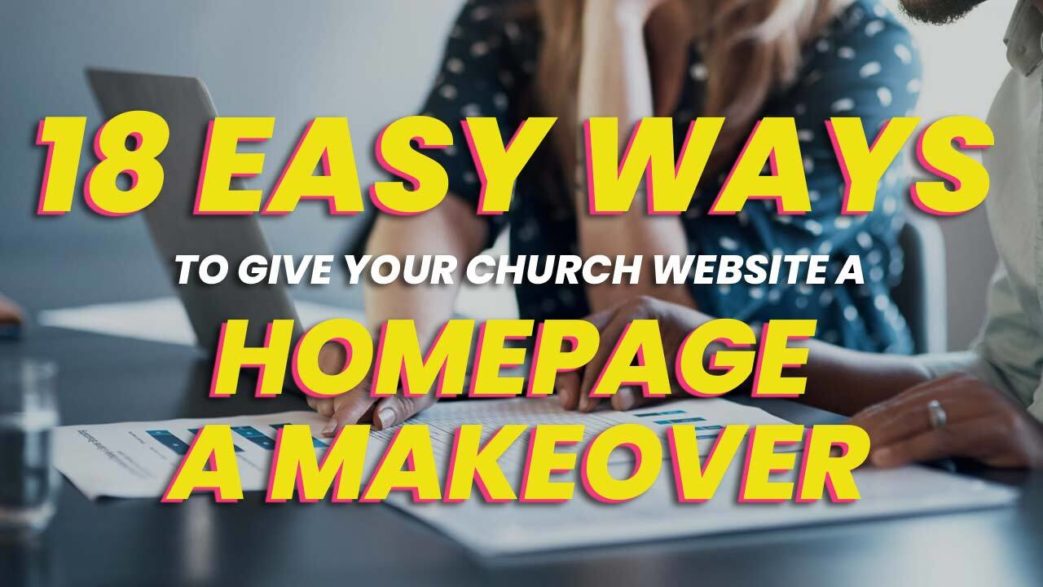You like to keep your church’s entrance neat, tidy and inviting, right? Your church website home page is the digital version of your entrance. This means it might need the occasional makeover to make the best first impression.
You don’t have to completely overhaul your church website, though. Even just a few simple tweaks can make a major difference in how visitors perceive and interact with your site.
If your home page hasn’t been updated in a while or just looks kind of stale and old, pick out a few things from the list below and enjoy the benefits of a fresh, new homepage.
Table of contents
- 1. Update Any Outdated Content
- 2. Add New Images
- 3. Add A Welcome Video
- 4. Put Your Mission Statement Front And Center
- 5. Rearrange Content Blocks
- 6. Change Your Theme
- 7. Adjust Font Sizing
- 8. Add An Engaging Headline
- 9. Make Your Logo Noticeable
- 10. Add A Search Function
- 11. Add An “I’m New” Section
- 12. Use Images With Each Content Block
- 13. Make Your CTA Stand Out
- 14. Add Page Teasers
- 15. Adjust Content Spacing
- 16. Get Rid Of Annoying Pop-ups
- 17. Answer Questions
- 18. Change Your Color Scheme
1. Update Any Outdated Content
The first step is to update any outdated content. It might seem like a simple way to give your church website home page a makeover, but outdated content is a red flag to visitors. For instance, if the last event listed on your home page was a year ago, visitors might not think your church is even active anymore.
Plus, outdated content could lead to fewer new visitors if anything related to hours, location or contact details has changed. After all, no one wants to try to visit a new church in person only to find out the worship hours aren’t what’s listed on the website.

2. Add New Images
Next, it’s time to spice up your images. Take a good look at your church’s home page. Does it seem like a lot of text without anything breaking it up? Are there pictures of your church or does it seem generic?
The first thing visitors notice when they arrive on your site is images. A beautiful picture of your church should be the first image visitors see when they arrive at your home page. While it’s fine to use a slideshow with different images, make sure one of them is definitely your church.
Avoid generic stock photos on this page. Using them on your church’s blog is fine. However, your church website home page needs to showcase your actual church. If possible, add images that include some of your members, a recent community activity, staff and other unique photography that helps show visitors more of your church’s personality.
3. Add A Welcome Video
Statistics show that videos create a much more engaging experience for users. Plus, you can explain so much more than you could in an image alone. If you don’t have any videos on your home page, add at least one. Some churches actually opt for an soundless video as their home page header image. This is usually just a quick clip that might show part of a worship service, members socializing before/after, community events, etc. Consider it a 15-30 second highlight reel that introduces people to your church.
You can also add a welcome video that includes audio. Use it to introduce the pastor, a few quick facts about your church, and how your church can help the visitor.
4. Put Your Mission Statement Front And Center
Does your home page have a mission statement front and center? Visitors look for a mission statement to learn the purpose of your church. It’s a simple, clear, one-sentence statement that encompasses your church’s purpose and priorities. This isn’t to be confused with a vision statement that’s more goal-oriented. Or, maybe it’s time to change your mission statement if it’s not clear enough or it’s too long.
Some churches use their mission statement as their home page headline. After all, it should be an impactful, motivating statement. Make sure this statement is above the fold, which is what users see without needing to scroll. Studies show that your above the fold content is incredibly important and can affect whether users scroll further or not.
If coming up with a mission statement has you stumped, Church Relevance, Serve HQ and Church Fuel have great tips and examples.
5. Rearrange Content Blocks
The layout of your content drastically affects how users interact with your website’s home page. For instance, when we talked about the fold, having your content in the right place guides users to scroll further down the page. This is especially important on mobile devices where you have even less screen space to make an impact.
For a quick makeover, change the layout of your content. Rearrange sections, space them out differently, stagger content, add images with the text, etc. Eye tracking studies can help you figure out the optimal layout. They’re also ideal for helping optimize your entire website.
Consider testing some different arrangements to see how your site performs to find the right design. You can also make small adjustments for a quick makeover in the future.
6. Change Your Theme
Speaking of layout, a quick and easy way to makeover your church website home page is to change your site’s theme. If you’re using a theme that hasn’t been updated in five years, it might be time to use something more modern. Plus, outdated themes might not be as optimized to load quickly.
Before you change your theme, please back up your site fully. Glitches happen and the last thing you want is a makeover turning into a lost website.

7. Adjust Font Sizing
You don’t necessarily have to change your fonts, but you can if you want to. Just make sure if you change the font itself, you change it for the entire site to have a uniform look and feel.
However, adjusting your font sizing and using emphasis, such as bold or H1, H2, H3, etc. headings, helps your content stand out more. No one likes reading “the fine print.” So, making content headings and their corresponding text easier to read on all devices helps people engage with your home page much more.
8. Add An Engaging Headline
If you’re not using your mission statement as your home page headline or you don’t have a mission statement, you should still have a headline to welcome visitors. Some churches actually have multiple headlines. This is usually only if they have multiple images or a video showing in the top portion of the page. Each image has a separate headline.
Pick something that embraces what your church stands for. Use an empowering statement that instantly draws visitors in and makes them want to be a part of your church’s community.
9. Make Your Logo Noticeable
If your church website home page already has a noticeable logo, great job! However, many churches still skip this. Instead, they just use an image of their church.
While there’s nothing wrong with that, a logo helps people instantly recognize your church wherever they engage with you online. This is especially true for churches with similar or identical names.
Ensure your church’s logo stands out in the head of your home page. It can be in the center, left or right side. This also makes your site look more professional. If you don’t have a logo yet, check out these logos for inspiration.
10. Add A Search Function
While this addition doesn’t really change the look of your home page much, it does change the functionality, which is just as important. If someone’s looking for something specific on your site, they don’t want to have to dig around for it. Instead, make life easy for them by adding a search function. Placing this at the top right corner or along either side makes it easy to find and use. You can also add a search feature to your site’s footer.
11. Add An “I’m New” Section
Many people who visit your church’s home page are completely new to your church. They’re either trying to find a new church or they’ve recently visited you in person the first time and want to know more. Give your home page a makeover by adding an “I’m New” or “New Here?” section. This should be a noticeable section with an engaging image and a brief welcome message. Then, use this section to link to the new visitor section of your site.

12. Use Images With Each Content Block
Every content block on your home page should have an image or at least a colorful background. This helps separate content and draws the eyes. Bolder, richer images should go with your most important content. Of course, if you’re adding text over an image, ensure the image doesn’t make the text hard to read. Solid color backgrounds often work for testimonials, contact details and hour information.
The images don’t have to be large. Some churches separate their site into strips, with each strip having its own image much like the header of your home page. Others have squares or rectangles with an image and some text below it or over it. Play around to see what looks best and ask your members to check it out to see what they like most.
13. Make Your CTA Stand Out
Want new visitors to check out your available resources and welcome message? Have a newsletter you want visitors to sign up for? Whatever your call-to-action might be, make it stand out. Changing the font, color and placement of your CTA changes how visitors interact with it. Some churches actually put their most important CTA near the headline area or just below the main home page image/video.
This not only makes your site more useful, but makes it look more organized. You can add secondary CTAs on the side of the page or further down.
14. Add Page Teasers
What can visitors expect when they start exploring your church’s website? A common, yet highly effective home page strategy is to use page teasers. Give each main page or section of your site a content block. Showcase the name and a brief description. This is more eye-catching than just a standard menu and helps people jump to important sections quickly. Plus, it’s a great way to add fresh content to your home page and make it look even better.
15. Adjust Content Spacing
Older home page designs tend to be more cluttered. This was before mobile devices were so prevalent. However, even as trends have changed, many sites still try to add as much content as possible to the home page. This makes it incredibly difficult to see where one section ends and another begins.
Make your church website home page seem more modern and user-friendly by spacing out content sections. White space guides the eye, makes the page look cleaner and aids in overall navigation, especially on small screens. It’s important to note that white space doesn’t literally mean having white spaces everywhere. Instead, it’s all about proper spacing, which UX Design explains perfectly.
16. Get Rid Of Annoying Pop-ups
Ask most people and they’ll tell you they hate pop-ups. In fact, the wrong pop-ups actually make people leave your site before they even check out your church’s home page. A quick makeover that’ll help keep visitors on your site and even boost conversions for your CTA is skipping the annoying pop-ups.
The key word here is “annoying.” In general, pop-ups that occur instantly, use all caps, have flashing components or have way too much text get ignored. Simple, straight-forward pop-ups that give the user a little time to see the home page before something appears work better. Active Campaign and Sumo showcase success stories and what those sites do differently.
Of course, a noticeable CTA can be just as effective if you’d rather skip the pop-ups completely.

17. Answer Questions
Think about the types of questions visitors often send your way. Could you answer any of those on your home page? For instance, do new visitors contact you about things they should know before visiting in person? This could be a hint to add that “I’m New” section we mentioned to your home page.
Use this makeover to answer some of the most common questions people have. This gives your home page more content, makes it more useful and keeps people on your site longer.
18. Change Your Color Scheme
This can be an iffy change, but one that truly stands out. Often, a church starts a website without any real strategy. They might pick a free template or site builder and compromise on the colors. Or, they just never chose a solid color scheme to use.
Take the time to choose colors that fit well with your church. If you use certain colors in your logo, that’s a great place to start. Ideally, keep the same color scheme throughout your entire online presence to make your church easier to recognize.
Is it time your church’s home page got a makeover? Contact us today to learn how we can help with your home page and entire website to make it more engaging and effective.




